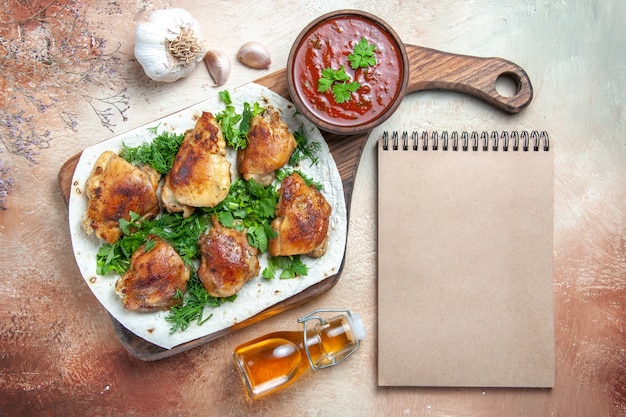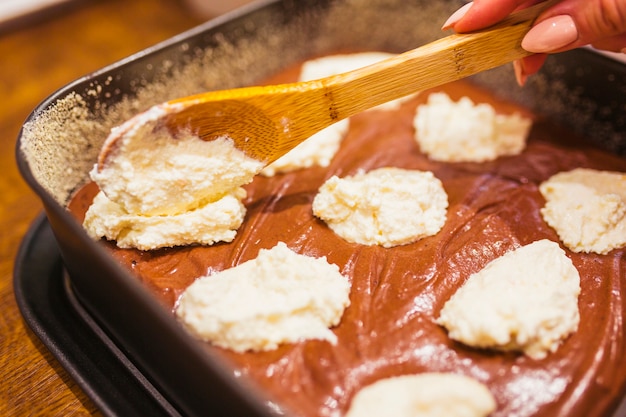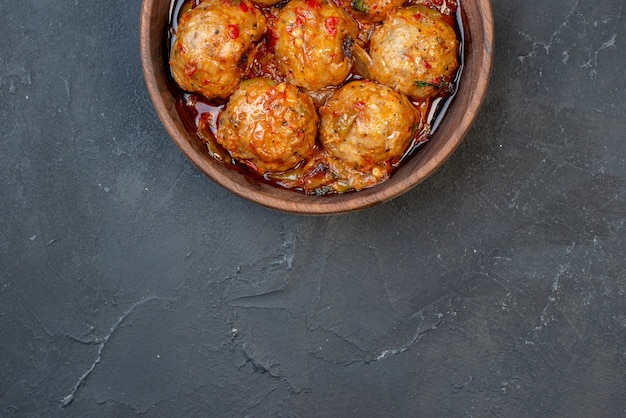Let's face it, everyone loves a good meatball. They're versatile, comforting, and always seem to disappear faster than you can say "marinara sauce." But getting those perfect, juicy meatballs can feel like a culinary puzzle, especially when it comes to oven baking. How long do you cook them? What temperature is best? Don't worry, I've been there, and I'm here to demystify the art of oven-baked meatballs, sharing my secrets for achieving consistently delicious results.
(Part 1) The Foundation: Choosing the Right Meat

You know what they say: you can't build a house without a solid foundation. The same goes for meatballs. The meat is the heart and soul of your creation, so choosing the right one is crucial. For a classic meatball, I usually gravitate towards a mix of ground beef and pork. The beef adds a robust flavor, while the pork brings a touch of tenderness and richness. But don't be afraid to get creative! Lamb, veal, or even a blend of ground chicken and turkey can add exciting variations.
The Fat Factor: Your Meatball's Best Friend
Now, some people shy away from fat, but in the world of meatballs, it's a true friend. Fat adds moisture, flavor, and that delightful "melt-in-your-mouth" texture we all crave. Don't be afraid to use meat with a good amount of fat content, you'll thank me later!
Building a Flavorful Base: Mixing It Up
Once you've got your chosen meat, it's time to create the magic. I like to add breadcrumbs or crushed crackers to my mixture for a bit of texture and to help everything bind together. Think of them as tiny little sponges soaking up the juices and keeping your meatballs moist. Next comes the fun part: flavoring. I'm talking about herbs, spices, and even some grated cheese. Remember, this is your chance to let your personality shine through! Just be sure to mix everything thoroughly so the flavors are evenly distributed. No one wants a meatball with a dry spot, right?
(Part 2) Rolling Your Way to Meatball Bliss

Alright, you've got your seasoned meatball mix. Now it's time to get your hands in there! Grab a generous portion, wet your hands to prevent sticking, and start rolling. The size of your meatballs is entirely up to you, but I prefer them around the size of a golf ball. Don't fret if they aren't perfectly round, a little rustic charm just adds to their appeal. The most important thing is to ensure they're all roughly the same size so they cook evenly. Think of it like a meatball orchestra, each member needs to be in tune for a harmonious outcome.
Giving Them Space to Breathe: Baking Sheet Etiquette
After rolling, you'll need to lay your meatballs out on a baking sheet. Now, remember that old saying "Don't overcrowd the dance floor?" It applies here too. Give your meatballs some room to breathe! You want air to circulate around them, preventing steaming and ensuring they cook evenly. If you're short on space, grab another baking sheet. It's better to have them spread out than create a meatball traffic jam.
(Part 3) The Oven-Baked Countdown: Cooking Times & Temperatures

Finally, we're at the heart of the matter: baking. Preheat your oven to 375°F (190°C). I've found this temperature to be the sweet spot for cooking meatballs. Now, let's talk about baking times, which depend on the size of your meatballs and how well-done you like them. But fear not, I have a general guide for you!
General Baking Times: A Handy Guide
Here's a handy guide to general baking times. Keep in mind that ovens can vary, so it's always a good idea to use a meat thermometer to ensure your meatballs are cooked through:
| Size | Time |
|---|---|
| Small (1 inch) | 20-25 minutes |
| Medium (1.5 inches) | 25-30 minutes |
| Large (2 inches) | 30-35 minutes |
Remember, these are just starting points. The best way to be sure is to use a meat thermometer. Insert it into the center of a few meatballs. They are cooked through when they reach an internal temperature of 165°F (74°C). This ensures they're safe and delicious.
(Part 4) Sauce It Up: The Perfect Pairings
Now, let's discuss the sauce! A meatball is nothing without its companion sauce. The beauty of meatballs is their versatility – they pair wonderfully with so many different flavors. I'm a big fan of classic tomato sauce, but the world is your oyster! You can go for creamy Alfredo, spicy marinara, tangy BBQ, or even a unique blend of your own creation. Go with what your heart (and taste buds) desire!
Finding Your Sauce Match: A Flavorful Journey
Here are a few sauce ideas to spark your culinary creativity:
- classic italian meatballs: A simple tomato sauce with a touch of garlic and basil is a timeless classic.
- Spicy Italian Meatballs: Add some red pepper flakes to your tomato sauce for a fiery kick.
- greek meatballs: A tangy lemon-herb sauce with a sprinkle of feta cheese brings a taste of the Mediterranean.
- Sweet and Sour Meatballs: A mix of sweet and sour sauce, ideal for a tangy and balanced flavor.
- BBQ Meatballs: A thick and smoky bbq sauce, perfect for a BBQ-style meal.
Finishing Touches: Elevating Your Meatballs
Once your meatballs are cooked and your sauce is chosen, it's time to bring it all together. You can either pour the sauce over the meatballs in the baking dish, letting them simmer and meld the flavors, or transfer them to a serving dish and pour the sauce on top. Either way, ensure the meatballs are well coated and allow them to simmer for a few minutes. A sprinkle of fresh herbs or a generous grating of Parmesan cheese adds a touch of elegance and rounds out the flavor profile.
(Part 5) Leftovers: Reheating Without Drying Out
You've cooked a glorious batch of meatballs, and you're left with some leftovers. But how do you reheat them without turning them into dry, flavorless disappointments? Here are a few methods that will keep your meatballs moist and delicious:
Oven Reheating: The Gentle Approach
Preheat your oven to 350°F (175°C). Place the meatballs in a baking dish, cover them with foil, and bake for 15-20 minutes, or until heated through. The foil acts as a barrier, preventing them from drying out. It's like giving them a warm, comforting hug!
Stovetop Reheating: A Quick and Easy Option
Heat a little bit of oil in a pan over medium heat. Add the meatballs and cook for 5-7 minutes, or until heated through. You can also add a little bit of sauce to the pan for extra flavor. This is a quick method, but keep an eye on them as they can dry out more easily than with other methods.
Microwave Reheating: The Quick Fix
This is the fastest method, but it's not always the best for reheating meatballs. Place the meatballs on a microwave-safe plate, cover them with a damp paper towel to retain moisture, and heat on high for 1-2 minutes, or until heated through. The paper towel helps to prevent the meatballs from becoming rubbery.
(Part 6) Meatball Mix-Ups: Exploring New Flavors
Let's get a little wild! Meatballs don't have to be just beef and pork. The world of meatball variations is vast, and there's a flavor adventure waiting for you. Here are some ideas to get your creative juices flowing:
Spicy Italian Meatballs with a Kick
Add a generous amount of red pepper flakes and a splash of hot sauce to your meatball mixture for some fiery flavor. Serve with a spicy marinara sauce for an extra kick.
Greek Lemon-Herb Meatballs
Replace some of the beef with ground lamb for a more Mediterranean twist. Add fresh oregano, parsley, and lemon zest to the meatball mixture. Serve with a lemon-herb sauce and a sprinkle of feta cheese.
Sweet and Sour Meatballs
Use a blend of ground pork and chicken for a lighter option. Add a tablespoon of honey and a splash of soy sauce to the meatball mixture for a sweet and savory flavor. Serve with a sweet and sour sauce for a tangy kick.
Mini Meatball Skewers
Roll small meatballs and thread them onto skewers. Bake them until cooked through. Serve with your favorite dipping sauce. These are a perfect appetizer or snack.
(Part 7) Beyond the Baking Sheet: Alternative Cooking Methods
Oven-baked meatballs are fantastic, but sometimes you want to explore new horizons. Here are a few alternative cooking methods to add some variety to your meatball repertoire:
Pan-Seared Meatballs: Crispy on the Outside, Juicy on the Inside
Heat some oil in a large skillet over medium heat. Add the meatballs and cook for 5-7 minutes, or until browned on all sides. Add your favorite sauce to the pan and simmer for a few minutes, or until the sauce has thickened. This method gives the meatballs a delicious crispy exterior and a tender, flavorful interior.
slow cooker Meatballs: Hands-Off Deliciousness
Place the meatballs in a slow cooker and add your favorite sauce. Cook on low heat for 4-6 hours, or until the meatballs are tender and the sauce has thickened. This method is perfect for a relaxed meal, as it requires minimal effort. Just set it and forget it!
Air Fryer Meatballs: Quick, Crispy, and Healthy
Preheat your air fryer to 400°F (200°C). Place the meatballs in the air fryer basket and cook for 10-12 minutes, or until cooked through and crispy. This method is quick and efficient, resulting in perfectly crispy meatballs with minimal oil.
(Part 8) meatball masterclass: FAQs
You've been a great student, asking thoughtful questions about meatballs. But I know you've got more burning inquiries. Here are some frequently asked questions about oven-baked meatballs:
1. What happens if I overcook my meatballs?
Overcooked meatballs become dry and tough. They're like a culinary ghost of their former selves! The best way to avoid overcooking is to use a meat thermometer and check the internal temperature. If you're unsure, it's better to slightly undercook them. You can always cook them a bit longer if needed, but you can't reverse the damage of overcooking.
2. Can I freeze meatballs before baking?
Absolutely! Freezing meatballs is a fantastic way to have a delicious meal ready to go in a pinch. Place them on a baking sheet lined with parchment paper and freeze until solid. Then transfer them to a freezer-safe bag. To bake from frozen, add an extra 10-15 minutes to the baking time.
3. What are some good side dishes for meatballs?
Meatballs are incredibly versatile and pair well with a wide range of side dishes. Some popular choices include:
- Pasta: A classic pairing that always hits the spot.
- Rice: A light and flavorful accompaniment.
- mashed potatoes: A creamy and comforting pairing.
- Roasted vegetables: Adds a burst of color and freshness to your meal.
- Salad: A refreshing and healthy addition.
4. Can I add other ingredients to my meatball mixture?
You bet! Get creative and experiment with different additions. Some popular ingredients include:
- Finely chopped onions: Adds a touch of sweetness and depth of flavor.
- Chopped garlic: A pungent and aromatic addition.
- Fresh herbs: Basil, parsley, and oregano add bright and fragrant flavors.
- Grated cheese: Parmesan, mozzarella, or even cheddar add creaminess and a savory edge.
- Diced vegetables: Carrots, celery, and peppers add texture and nutritional value.
5. What if my meatballs stick to the baking sheet?
To prevent meatballs from sticking to the baking sheet, spray the sheet with non-stick cooking spray or line it with parchment paper. A little preparation goes a long way in preventing a sticky situation!
And there you have it, my meatball manifesto! I've shared all my tips and tricks, empowering you to create delicious, juicy meatballs that will impress everyone. Now, go forth and conquer the world of meatballs with confidence. Happy cooking!
Everyone is watching

Perfect Rice Every Time: The Ultimate Guide to Cooking Rice
Cooking TipsAs a self-proclaimed foodie, I've always been a bit obsessed with rice. It's the foundation of countless cuisi...

Prime Rib Roast Cooking Time Chart: Per Pound Guide
Cooking TipsPrime rib roast. Just the name conjures images of lavish dinners, crackling fires, and hearty laughter. It’s ...

The Ultimate Guide to Cooking Asparagus: Tips, Techniques, and Recipes
Cooking TipsAsparagus. The mere mention of this spring delicacy conjures up images of vibrant green spears, crisp and burs...

Ultimate Guide to Cooking the Perfect Thanksgiving Turkey
Cooking TipsThanksgiving. Just the word conjures up images of overflowing tables laden with delicious food, the scent of r...

How Long to Bake Potatoes in the Oven (Perfect Every Time)
Cooking TipsBaked potatoes are a staple in my kitchen. They're incredibly versatile, delicious, and surprisingly easy to m...
